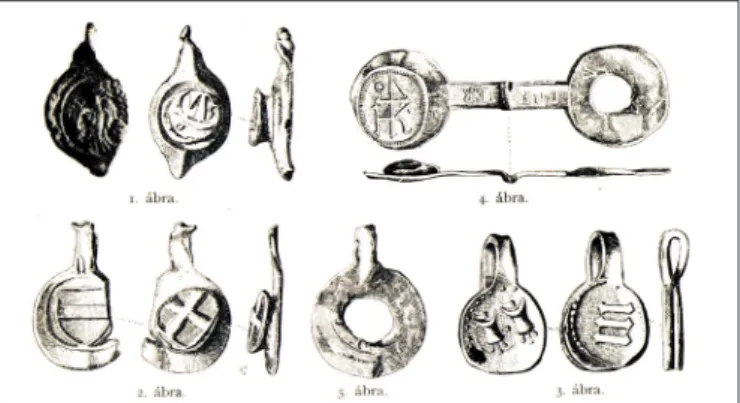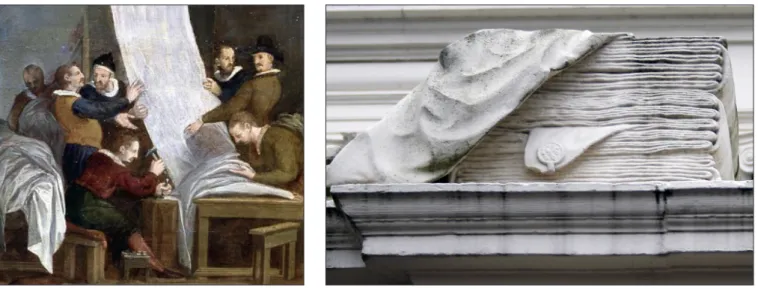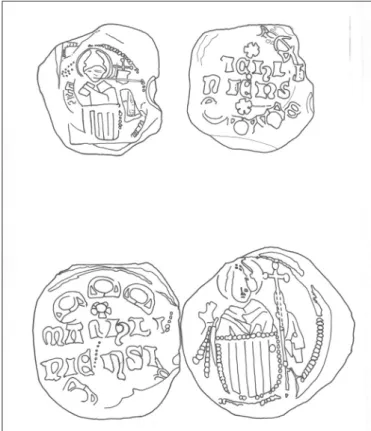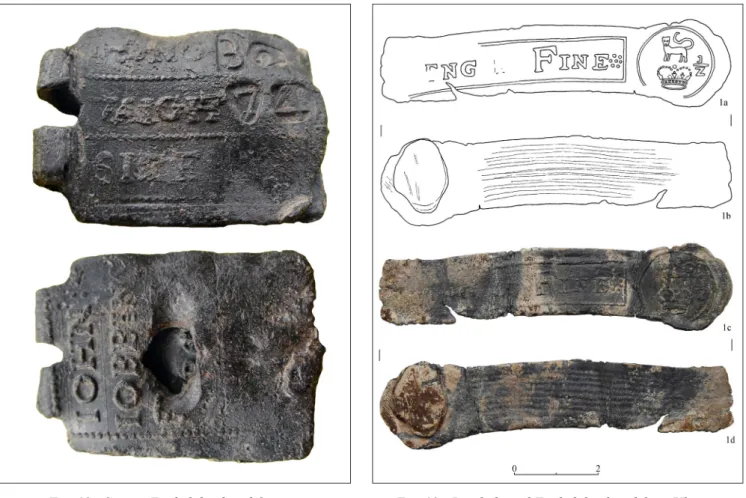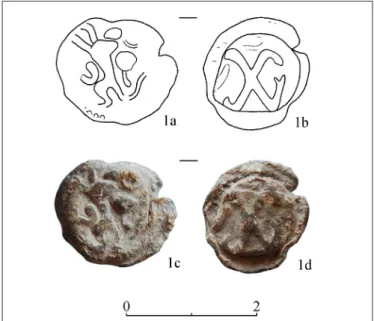were only a few dozen of these seals known from the Carpathian Basin. Even these were often in private ownership and the scholarly literature hardly talked about them. This situation changed radically starting in the 1990s, when the number of finds increased by leaps and bounds, as well as in 2011 when the attention of the colleagues was drawn to these finds due to the excavations at Pápa. Since then, Hungarian research into lead seals has been trying to catch up to the level abroad, and we can state without modesty that this has met with success.
When the lead seals (Fig. 1) found by László Juhász in the area of the Roman fort at Dunaszekcső in 1901 had been properly identified and published in the pages of the Archaeologiai Értesítő (Archaeo- logical Bulletin) (Juhász 1901: 174–175), or in 1911 when Manó Toch handed over the objects in his col- lection, including four lead seals that were indicated as such (Mordovin 2018: 11, 26), they certainly did not think that they possessed such unique knowledge that later would be lost for more than half a century in Hungary. Both of them probably proceeded on the cutting edge of European research without even knowing it, since at that time only French and Bel-
gian numismatic colleagues had studied a similar subject. In my present essay, I summarize the experiences up to this point related to the process of identification and I provide advice to those readers not as familiar with the research on the subject for how to attempt to independently identify a specific lead seal, if the given example happens to be missing from the available publications and catalogues.
Fundamentally three factors can be taken into account when identifying the lead seals: the method in which they are affixed, the form of the lead seal and the “pattern”. The latter comprises everything that the engraver wanted to portray on the stamp image when it was applied (pinched or pressed on). Naturally, the three factors cannot be considered equivalent during the course of identification. It is only the third factor, or the specific versions of the “pattern” that make it possible to determine the undoubted origin of the lead seal with full certainty. The other two factors can at most help to narrow the area that must be examined if we have no other clues. Approaching the question from the direction of greatest uncertainty – if the “pattern” has not survived – the method in which it is fastened or attached is examined first. Surprisingly, for certain finds, even this can provide pretty good information. The overwhelming majority of medieval lead cloth seals were riveted. This means that it was attached to the edge of the bolt of cloth in such a way that this edge was perforated by a rivet between the two disks linked by a small metal band, and then the rivet was hidden in the perforated disk
1 Eötvös Loránd University, Institute of Archaeology. The author is a member of the Hungarian Academy of Sciences Research Center for the Humanities “Momentum” Medieval Hungarian Economic History Research Group. His research has been supported by the NKFI PD 115912 grant.
Fig. 1.: László Juhász’s publication on lead seals – the first in Hungary (Juhász 1901)
and this was pressed together (they were hammered together, like with the minting of coins or were pressed together with a special clamp, Figs. 2-3). However, during the Middle Ages, there were also at least two other methods to affix them in addition to the riveted versions (Fig. 4). One was similar to above, but without a rivet, and only comprised of two connected flat disks, but how they were pressed together was similar. Since these are relatively large, with a diameter of 3.5-4 cm, in essentially every case they remained on the bolt of fabric even without a rivet due to their size. In addition, there was another version at the same time, which in its raw form was most commonly comprised of a small lead cylinder, or in rare cases a thick disk, through which there was a thin channel. Thus, these were attached not to the edge of the fabric, but instead to a string or cord, and did not indicate the quality of a single bolt of cloth, but served to seal an entire bale. This is supported by the fact that there is no chronological difference between the various methods of attachment.
What can we do with the attachment methods listed above? Fortunately, certain tendencies can be observed amongst the Hungarian finds. Immediately it can be pointed out that the tubular, bulla-type lead seals in the Carpathian Basin primarily fall under the same classification as the modern types that spread from the
Fig. 2.: The placement of the seal indicating quality on the bolt of cloth: detail from the image made
around 1594 by Isaac Claesz. van Swanenburg (wikipedia commons)
Fig. 3.: Lead seal on the edge
of a bolt of cloth on the 17th century portal relief at the Cloth Hall in Leiden
(photograph by the author)
Fig. 5.: Cylindrical lead seal from Tournai in the F. Balázs Csáti collection of the Hungarian National Museum
(Mordovin 2014) Fig. 4.: Lead seal types that also
appear in the Carpathian Basin (Mordovin 2018)
ently there is only a single regular, disk-shaped, bul- la-type lead seal known from Hungary that has been successfully identified. This is an example from Mechelen that Richárd Balga, an amateur archae- ologist, found near Alsótold (Fig. 6). According to observations made up to this point, these types of lead cloth seals turning up within the territory of the medieval Kingdom of Hungary are from textile centers in the southern Netherlands and may have arrived here during the 14th-15th centuries. In inter- national comparison, it can also be observed that identifiable examples attached in this manner were made in the cities of present-day northern France, Belgium and southern Holland. The only difference in comparison to the Hungarian examples is that in the west their use goes far beyond the Middle Ages.
The situation with the lead seals without rivets is even more interesting – and perhaps more straight- forward as well. As with the previous type, these are not common. With one exception, the some eighty examples are all textile seals of English character (here I will not delve into the complicated issue of the actual site of their production, see: Mordovin
2018, 244–255). All of them can be dated to the final third of the 16th century, and perhaps we can be so bold as to narrow the period of their produc- tion to between 1570 and 1596. It is important to emphasize that these are statements that can only
be made for finds from the Carpathian Basin, it has not yet been possible to precisely survey this type internationally. (Fig. 7).
If we find a riveted lead seal, then we are faced with a much more difficult task, since of the some 1,600 examples known to this point, 1,100 – or almost 70% – were certainly affixed in this manner, and this does not even include the fragments where we also suspect that this is the case. The question arises, to what extent does the attachment method aid in determining the place of origin? Fortunately, the forms of rivet- ing are not completely identical. The first noticeable difference is the number of rivets, since there are lead seals with either one or two rivets. The latter version is far rarer, so in this case certain regularities can be observed. The western researchers have already noticed that they differ from the more abundant single-rivet examples in terms of chronology and geographical distribution. It is certain that they appeared later, since while the earliest known lead cloth seal is from 1275, and it was mostly this type that was in use during the
Fig. 6.: Two cylindrical lead seals of Mechelen from unknown sites (private collection, drawings by Katalin Szegleti)
Fig. 7.: English-style pressed lead seal from Variaş, Romania (find and photograph by István Bacskai)
course of the 14th century, the double-riveted examples – including ones of this type from Tournai – can be documented to the final third of the 14th century and their use spread in the course of the 15th century. If there is no other identifying data, the double-riveted lead seals are fundamentally characteristic of the Nether- lands and the areas immediately bordering it. Included here are the north-western band of present-day Ger- man with the city of Aachen, as well as England. The profile is somewhat blurred by the fact that amongst the Hanseatic cities, raw seals of this type have also been found in Gdansk (Kocińska–Maik 2004, 69).
However, besides this, up to this point no other lead seals of this type that can be positively identified to towns in Poland or Germany have been found, and furthermore, without exception, there are no lead seals from Gdansk known in the Carpathian Basin. Amongst the double-riveted lead seals that can be determined with certainty in Hungary, this type can be linked to fabrics from Tournai, Arras, Ypres and Tienen, as well as Aachen and England (Figs. 8-9). Chronologically these – discounting the examples from England – can be dated to between the end of the 14th century and the end of the 15th century. The examples from Mechelen
that have a less certain identification can also be placed in this time period.
There are also more conspicuous types that can be separated out from the single-riveted lead seals. These include the examples where the rivets have flat ends and due to this are more difficult to press together, so they regularly stick out further from the surface of the perforated disk. This is one of the apparent differen-
Fig. 9.: Double-riveted lead seal from Tournai in the F. Balázs Csáti collection of the Hungarian National Museum
(Mordovin 2014)
Fig. 11.: Lead seals from Görlitz with protruding rivets from a private collection in Szolnok
drawing: Katalin Szegleti) Fig. 8.: Double-riveted English-style lead seal from Túrkeve-
Móric (Hungarian National Museum, published:
Mordovin 2014)
Fig. 10.: Extremely worn Venetian lead seals in the F. Balázs Csáti collection of the Hungarian National Museum (drawing
by Katalin Szegleti)
tiating marks of the Venetian textile tags (Fig. 10). It can often be observed with these that due to the rivet protruding from a back side that has hardly been pressed together, the impression of the stamp cannot be seen or is incomplete. Amongst the more unusual variations, there are certain versions of the lead seals from Görlitz where the rivets are so long that after being pressed on they clearly protrude past the disk (Fig. 11).
Moving on from the formal elements, it is worthwhile to dwell a little bit on Venetian textile tags. Alongside the characteristic rivet, certain Venetian types also have special shapes. While the majority of lead seals – as was mentioned above – are disk shaped, the Venetian badges are more elongated with a slightly oval shape and a gently narrowing end opposite the connecting strip (Fig. 10). In addition, these lead seals have much thicker disks than the average, with the edges bevelled diagonally towards the center. Since this shape does not appear anywhere else, even the most worn Venetian lead seal can be recognized. Others that have a noticeably differ- ent shape from the rest hardly appear in the Hungarian finds, so every single occurrence is apparent. Since we cannot know what kind of finds will be discovered, it is worthwhile to briefly touch upon the most important variations. Already from the beginning we can state that the oddities can almost exclusively be linked to the English textile industry. Square lead seals appear in the English finds starting from the 16th century (Egan 1994, Fig. 15:36; Fig. 26: 117–118, 128). These contained for the most part master’s marks or information about the length and width of the fabric (Fig. 12). Outside of England these types appear relatively rarely, primarily in the cities of the Netherlands (pl. Amsterdam: BaartEt al. 1977, 119, 121). A later version of this is a large, band-like “stamp”, which indicates the length and weight of the inspected bolt of cloth. Since these have already been found in the western region of Ukraine (Fig. 13), we can expect similar types in the Carpathian Basin as well. The function of the band-like part was clearly to provide a surface for the increasing information necessary due to more complex regulations. In England they found another – more frequently employed – solution to this problem, they doubled the number of disks (Fig. 14). These variations appear with
Fig. 12.: Square English lead seal from an unknown site
(private collection)
Fig. 13.: Band-shaped English lead seal from Ukraine (Archaeological Museum of the Uzhhorod National
University, drawing by Igor Prohnenko)
great frequency and diversity from the 16th century in London and other English archaeological sites (see Egan’s 1994 catalogue). The examples that are made up of two double disks connected to one another, turn up rather frequently in the cities of western Europe and finds such as this are also known from Poland (BoBowski 2009, 78 Nr. 49) and Ukraine. In England,
these are the stamps issued by the royal inspection agency (alnage) in every case, and in accordance with this, there was a coat-of-arms of the monarch or the country or a portrait of the ruler on one of the disks (Egan
1994, Fig. 27–28). In one case, three disks can be seen next to one another (Egan 1994, Fig. 29: 200). This type of find is not yet known in the Hungarian materials, but its appearance in Poland and Ukraine make it conceivable that it will turn up in the Carpathian Basin as well.
Finally, we must also touch upon the issue of the “pattern”. While this seems completely unambiguous, aggravatingly the stamp mark has often survived in a very worn or very damaged condition, and it is of no use to see a fragment of a coat-of-arms or inscription if it is so incomplete that we gain no useful infor- mation from it. Fortunately, there are certain customs and tendencies that can be identified here, that when combined with the other observations listed above may provide the opportunity for a precise identification.
One of these “customs” is the placement of the coat-of-arms or the image that alludes to it and the inscrip- tion together on the two sides of the lead seal. It seems that this characterized the lead seals from the more important textile cities of present-day eastern Germany and Poland. There was the coat-of-arms of the city or a detail of it on the obverse, while on the reverse there was the city’s name divided in several sections.
For example, there are tags of this type from Chojnów, Zielona Góra and Lwówek Śląski (Fig. 15). The reason for this perhaps can be sought in the fact that the coats-of-arms of the cities in this area were very similar, usually some kind of city gate. In the southern parts of Germany (in particular Bavaria), in addition
Fig. 15.: Lead seal of Lwówek Śląski: a combination of the coat-of-arms and inscription (Archaeological Museum of the
Uzhhorod National University, drawing by Igor Prohnenko)
Fig. 16.: Lead seal of Memmingen from the Hungarian National Museum
Fig. 14.: Double English lead seal from Poland (collection of the Eötvös Lorand University, School of the Humanities,
Institute of Archaeology)
Fig. 17.: Lead seal of Gdańsk with the indication of quality (private collection)
long time, the criteria introduced in this essay can provide assistance in these cases to narrow the region to be searched (Fig. 18). It is my hope that with this summary I have provided assistance in the interpretation of numerous medieval and Early Modern period lead seal types that are unpublished or do not appear in catalogues. However, the exam- ples that will be found in the future will further fill out this outline of the situation.
BiBliographyand rEcoMMEndEd litEraturE: Baart, JanEtalii 1977:
Opgravingen in Amsterdam. 20 jaar stadtskern onderzoek (Excavations in Amsterdam. 20 years of the research of the city centre). Amsterdam: Fibula-van Dishoeck.
BoBowski, Bogdan 2009:
Plomby tekstylne z wykopalisk na terenie Dolnego Miasta w Gdańsku (Textile seals from the excavations on the territory of the Lower Town of Gdańsk). Łódź: Wydawnictwo Wyższej Szkoły Edukacji Zdrowotnej w Łodzi.
Egan, gEoff 1994:
Lead Cloth Seals and Related Items in the British Museum. London.
hittingEr, diEtEr 2008:
Tuchplomben. Warenzeichen des späten Mittelalters und der Neuzeit aus dem norddeutschen Küstengebiet (Cloth seals. Trade badges from the late Middle Ages and Modern Time from the northern German coastal region). Aachen: Shaker Verlag.
Juhász lászló 1901:
Baranya megyei leletekről (About Finds from Baranya County). Archaeologiai Értesítő 21, 174–176.
KocińsKa, Maria Karolina – MaiK, Jerzy 2004:
Średniowieczne i nowoźytne plomby tekstylne z wykopalisk w Gdańsku (Medieval and modern textile seals from the excavations in Gdańsk). Łódź: Instytut Archeologii i Etnologii PAN – Muzeum Archeologiczne w Gdańsku.
Fig. 18.: Lead seal with a lion coat-of-arms from Zittau, with a letter Z indicating the name of the city (Archaeological Museum of the Uzhhorod National University, drawing by
Igor Prohnenko)
Mordovin, MaxiM 2014:
Late Medieval and Early Modern Cloth Seals in the Collection of the Hungarian National Museum.
Archaeologiai Értesítő 139, 193–237.
Mordovin MaxiM 2018:
Textilvégek védjegyei. A textilkereskedelem régészeti emlékei a Magyar Királyság területén (Trademarks of Bolts of Cloth. The Archaeological Remains of the Cloth Trade in the Territory of the Kingdom of Hungary). Budapest: MTA Bölcsészettudományi Kutatóközpont Történettudományi Intézet.
